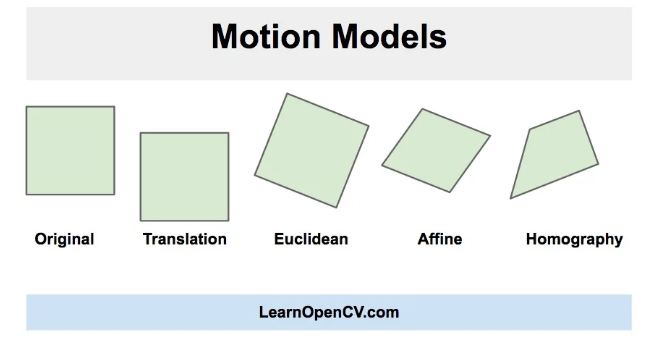需求:
同一位置不同时间拍20张照片或多或少有些偏移,需要矫正。
解决思路:
原理就不介绍了,就是简单的图片配准(找关键点、关键点匹配、筛选关键点、计算变换矩阵、变换)
参考:
网上搜了下大致有两种思路,试过效果都不错:
-
一、利用ORB/SURF提取特征点、查找单应性矩阵、对图片变换
stackoverflow上一个回答(ORB)
https://stackoverflow.com/questions/6418742/how-to-register-an-image-manually-image-registration
OpenCV的图像配准融合(SURF)
https://blog.csdn.net/qq_27737701/article/details/82289607
Opencv官网对这一块的介绍
https://docs.opencv.org/3.4.2/db/d61/group__reg.html -
二、Image Alignment (ECC) in OpenCV
这个介绍的比较详细了
https://www.learnopencv.com/image-alignment-ecc-in-opencv-c-python/
使用:
opencv配准对其时候有四种方式:平移、欧几里得、仿射、单应。变换矩阵详细介绍
具体使用哪一种看自己需求:比如我只希望进行图片的平移和旋转,不希望造成图片的畸变,所以我用Euclidean。

代码:
就是摘自上边的链接利用ORB/SURF提取特征点、查找单应性矩阵、对图片变换、Image Alignment (ECC) in OpenCV 细微的改动了下。
利用ORB/SURF提取特征点、查找单应性矩阵、对图片变换
1
2
3
4
5
6
7
8
9
10
11
12
13
14
15
16
17
18
19
20
21
22
23
24
25
26
27
28
29
30
31
32
33
34
35
36
37
38
39
40
41
42
43
44
45
46
47
48
49
50
51
52
53
54
55
56
57
58
59
60
61
62
63
64
65
66
67
68
69
70
71
72
73
74
75
76
77
78
79
80
81
82
83
84
85
86
87
88
89
90
91
92
93
94
95
96
97
98
99#include <opencv2/opencv.hpp> #include "opencv2/xfeatures2d.hpp" #include "opencv2/features2d.hpp" using namespace std; using namespace cv; using namespace cv::xfeatures2d; const int MAX_FEATURES = 500; const float GOOD_MATCH_PERCENT = 0.15f; void alignImages(Mat &im1, Mat &im2, Mat &im1Reg, Mat &h) { Mat im1Gray, im2Gray; cvtColor(im1, im1Gray, CV_BGR2GRAY); cvtColor(im2, im2Gray, CV_BGR2GRAY); // Variables to store keypoints and descriptors std::vector<KeyPoint> keypoints1, keypoints2; Mat descriptors1, descriptors2; // Detect ORB features and compute descriptors. Ptr<Feature2D> orb = ORB::create(MAX_FEATURES); orb->detectAndCompute(im1Gray, Mat(), keypoints1, descriptors1); orb->detectAndCompute(im2Gray, Mat(), keypoints2, descriptors2); // Match features. std::vector<DMatch> matches; Ptr<DescriptorMatcher> matcher = DescriptorMatcher::create("BruteForce-Hamming"); matcher->match(descriptors1, descriptors2, matches, Mat()); // Sort matches by score std::sort(matches.begin(), matches.end()); // Remove not so good matches const int numGoodMatches = matches.size() * GOOD_MATCH_PERCENT; matches.erase(matches.begin()+numGoodMatches, matches.end()); // Draw top matches Mat imMatches; drawMatches(im1, keypoints1, im2, keypoints2, matches, imMatches); imwrite("matches.jpg", imMatches); // Extract location of good matches std::vector<Point2f> points1, points2; for( size_t i = 0; i < matches.size(); i++ ) { points1.push_back( keypoints1[ matches[i].queryIdx ].pt ); points2.push_back( keypoints2[ matches[i].trainIdx ].pt ); } // Find homography h = findHomography( points1, points2, RANSAC ); // Use homography to warp image warpPerspective(im1, im1Reg, h, im2.size()); } int main(int argc, char **argv) { // Read reference image string refFilename("form.jpg"); cout << "Reading reference image : " << refFilename << endl; Mat imReference = imread(refFilename); // Read image to be aligned string imFilename("scanned-form.jpg"); cout << "Reading image to align : " << imFilename << endl; Mat im = imread(imFilename); // Registered image will be resotred in imReg. // The estimated homography will be stored in h. Mat imReg, h; // Align images cout << "Aligning images ..." << endl; alignImages(im, imReference, imReg, h); // Write aligned image to disk. string outFilename("aligned.jpg"); cout << "Saving aligned image : " << outFilename << endl; imwrite(outFilename, imReg); // Print estimated homography cout << "Estimated homography : n" << h << endl; }
Image Alignment (ECC) in OpenCV
1
2
3
4
5
6
7
8
9
10
11
12
13
14
15
16
17
18
19
20
21
22
23
24
25
26
27
28
29
30
31
32
33
34
35
36
37
38
39
40
41
42
43
44
45
46
47
48
49
50
51
52
53
54
55int main(int, char **) { // 【1】图像对齐(配准) // 读取图像 Mat im1 = imread("/home/yx/Desktop/11/_0.png"); Mat im2 = imread("/home/yx/Desktop/11/_18.png"); // 将图像转换为灰度; Mat im1_gray, im2_gray; cvtColor(im1, im1_gray, CV_BGR2GRAY); cvtColor(im2, im2_gray, CV_BGR2GRAY); // 定义运动模型 const int warp_mode = MOTION_EUCLIDEAN; // MOTION_TRANSLATION 平移 // MOTION_EUCLIDEAN 欧几里得 // MOTION_AFFINE 仿射 // MOTION_HOMOGRAPHY 单应性 // 根据运动模型设置2x3或3x3变形矩阵。 Mat warp_matrix; // 初始化矩阵以进行标识 if ( warp_mode == MOTION_HOMOGRAPHY ) { warp_matrix = Mat::eye(3, 3, CV_32F); } else { warp_matrix = Mat::eye(2, 3, CV_32F); } // 指定迭代次数。 int number_of_iterations = 50; // 指定两次迭代之间相关系数增量的阈值 double termination_eps = 1e-10; // 定义终止条件 TermCriteria criteria (TermCriteria::COUNT + TermCriteria::EPS, number_of_iterations, termination_eps); //运行ECC算法。结果存储在warp_matrix中。 findTransformECC( im1_gray, im2_gray, warp_matrix, warp_mode, criteria ); // 存放变形的图像。 Mat im2_aligned; warpAffine(im2, im2_aligned, warp_matrix, im1.size(), INTER_LINEAR + WARP_INVERSE_MAP); // 显示最终结果 imshow("Image 2", im2); imshow("Image 2 Aligned", im2_aligned); //【2】图像平滑 (高斯滤波) qint32 kernel_length = 3; GaussianBlur(im2_aligned, im2_aligned, Size(kernel_length, kernel_length), 0, 0); imshow("Image 2 Aligned GaussianBlur", im2_aligned); //【3】图像去血管 waitKey(0); }
最后
以上就是谦让镜子最近收集整理的关于利用opencv实现图片的配准/对齐的全部内容,更多相关利用opencv实现图片内容请搜索靠谱客的其他文章。








发表评论 取消回复